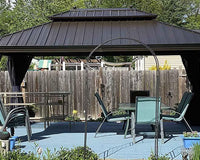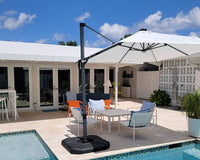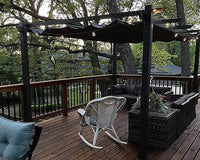Although it seems easy, selecting the appropriate umbrella size for your patio table can make all the difference between ideal outdoor comfort and annoying shadow gaps. A correctly sized patio umbrella guarantees everyone stays covered from the sun while keeping a balanced, attractive look, whether you're having family brunches, backyard parties, or just lounging outside. This guide will cover all you need to know to choose the ideal umbrella size for your patio table, therefore guaranteeing you make a wise purchase to improve your outdoor environment.
A Simple Guide to Match Patio Table and Umbrella Size
Standard Table and Umbrella Pairings:
Round Tables:
- 30-36 inch table → 7-8 foot umbrella
- 40-48 inch table →9 foot umbrella
- 54-60 inch table → 11 foot umbrella
Rectangular/Square Tables:
- 4-6 seat table (up to 64 inches) → 9 foot umbrella
- 6-8 seat table (up to 84 inches) → 11 foot umbrella
- 8-10 seat table (up to 96 inches) → 13 foot umbrella
Coverage Guidelines:
- Umbrella should extend 2 feet beyond table edges on all sides
- Allow 4-5 feet of shade per seated person
- For square tables, measure diagonally to ensure full corner coverage
Height Placement Tips:
- The bottom of the umbrella should be 7 feet from the ground for clearance
- Allow 12-14 inches from tabletop to umbrella pole hub
- Account for umbrella tilt angle in final height calculations

How to Calculate Your Perfect Patio Umbrella Size
Start by measuring your patio table's width and length (or diameter for round tables) using a tape measure. For the most accurate measurement, include an additional 4 feet (2 feet on each side) to ensure proper shade coverage for seated guests. For example, if your round table is 48 inches in diameter, you'll need an umbrella that's at least 96 inches (8 feet) in diameter to provide adequate coverage.
The basic calculation formula follows a simple rule: Table Width/Diameter + 4 feet = Minimum Umbrella Size. For rectangular tables, use the longer side as your base measurement. Square tables require special attention—measure diagonally from corner to corner and add 4 feet to ensure complete coverage of all corners. Umbrella sizes typically come in whole feet (7', 9', 11', etc.), so round up to the nearest size available.
Common measurement errors should be avoided by considering chair pullout space (usually 18–24 inches from table edge) and by not measuring simply the table surface without regard for the real seating area. Ignoring any table overhang or elongated edges that can influence the location of the umbrella pole is another common mistake.
Change your approach depending on the unusual table forms. Measure oval tables using the longest length as your guide, much like rectangular tables. Measure the widest point for hexagonal or octagonal tables exactly as for a round table. Measure the biggest dimensions of your table when it is completely extended to guarantee sufficient coverage in all possible configurations if its form or extension is odd.
How Does Your Environment Affect Your Patio Umbrella Choice?
Local Weather and Positioning
Your patio umbrella should complement the surroundings rather than fight them. If you live in a breezy coastal area, think about scaling down somewhat from the maximum advised size—a 9-foot umbrella may be safer than an 11-foot one. The perfect umbrella should resist gusts up to 15 to 20 mph; however, on blustery days, anything bigger than your computed minimum size could pose a safety risk.
Sun Patterns and Coverage
Think about the direction of your patio and the usual solar patterns. Larger umbrellas may be necessary for south-facing patios to adjust for the shifting sun angle all day. Track the sun's path across your patio for a day; you may find that a somewhat larger umbrella or one with a tilting function better fits your area than a standard-sized fixed type.
Seating Dynamics
Consider how others use your space. Add an extra foot to your predicted umbrella size if your guests often take seats away from the table or reposition seating for conversation. Make sure there is enough coverage overlap in spaces for conversation where individuals might sit between tables to avoid embarrassing pole placement problems.
Space and Safety Considerations
- Vertical clearance: Ensure a 7-foot minimum height from the ground to the umbrella edge
- Distance from structures: Keep at least 2 feet from walls or fences
- Walkway space: Maintain clear paths with at least 3 feet of walking space
- Storage space: Consider where you'll store the umbrella during off-season or severe weather
Multiple Umbrella Planning
You could want many umbrellas for bigger areas or oddly shaped tables. To prevent sun gaps, figure coverage areas with a 1-2 foot overlap between umbrellas. Position poles to reduce interference with sitting and guarantee that every umbrella can run free from tangling.
How Do Different Settings Affect Your Umbrella Size Choice?
Residential Patios
In household settings,a 9-foot umbrellan patio set exactly. Give built-in elements like outdoor kitchens or fireplaces three feet of clearance, and make sure there is enough room for occasional entertainment and casual family get-togethers.
Commercial Spaces
Business areas need strategic planning:
- 11-foot umbrellas for larger gathering areas
- 6-8 foot spacing between umbrellas
- 4-foot clearance for server access
- ADA-compliant 36-inch pathways
Pool Areas
Pool settings require:
- 11-13 foot umbrellas for lounging areas
- Extra coverage for shifted furniture
- Higher placement for safety equipment
- Cantilever options to avoid pole interference
Restaurant Settings
Dining areas demand precise sizing:
- 7-9 foot umbrellas for 2-4 person tables
- 9-11 foot for larger dining groups
- Clear sightlines to service areas
Balcony Considerations
Small spaces need smart solutions:
- 6-7 foot umbrellas for compact areas
- Half-umbrellas against walls
- Wind resistance for higher elevations
- Building code compliance

How Do Umbrella Features Impact Your Shade Coverage?
Canopy Designs and Their Impact
Different canopy shapes affect coverage differently:
- Octagonal: Most common, provides even shade distribution
- Square: Better for square/rectangular tables, minimizes shade gaps
- Rectangle: Ideal for long dining tables, offers focused coverage
- Vented: Allows heat escape and wind flow; may create small light gaps
Smart Tilt FeaturesModern umbrellas offer varied tilt options:
- Push-button tilt - Easy angle adjustments for sun tracking
- Auto-tilt - Smooth operation for frequent adjustments
- Collar tilt - More stable in windy conditions
- No tilt - Maximum stability, but fixed coverage area

Pole Placement Matters
- Center pole: traditional; works with most tables with holes
- Offset/cantilever: maximizes usable space, no pole interference
- Side mount: good for balconies and small spaces
- Dual post: Extra stability for larger umbrellas
Material Effects on Coverage
- Sunbrella® fabric - Dense weave for optimal sun-blocking
- Polyester - Lightweight, may allow some light through
- Olefin - Good UV protection, quick-drying
- Canvas - Heavy-duty but may fade faster




